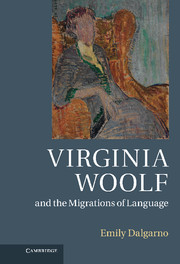Book contents
- Frontmatter
- Contents
- Preface
- Abbreviations
- The migrations of language: introduction
- Chapter 1 Translation and ethnography in “On Not Knowing Greek”
- Chapter 2 Antigone and the public language
- Chapter 3 Tolstoy, Dostoyevsky, and the Russian soul
- Chapter 4 Proust and the fictions of the unconscious
- Chapter 5 Translation and iterability
- Chapter 6 Assia Djebar and the poetics of lamentation
- Conclusion
- Bibliography of works cited
- Index
The migrations of language: introduction
Published online by Cambridge University Press: 07 October 2011
- Frontmatter
- Contents
- Preface
- Abbreviations
- The migrations of language: introduction
- Chapter 1 Translation and ethnography in “On Not Knowing Greek”
- Chapter 2 Antigone and the public language
- Chapter 3 Tolstoy, Dostoyevsky, and the Russian soul
- Chapter 4 Proust and the fictions of the unconscious
- Chapter 5 Translation and iterability
- Chapter 6 Assia Djebar and the poetics of lamentation
- Conclusion
- Bibliography of works cited
- Index
Summary
The need to change the structure of the English sentence in order better to meet the requirements of women writers is a constant theme in the work of Virginia Woolf. She wrote during a period when the goals of translation were undergoing fundamental changes that enlarged and facilitated that project. The British translator who was compelled to observe the ethnocentric standards of Greek translation in the university evolved within a few decades into a figure whose aim, in response to the demands of colonial readers, was to mediate between cultures. It is the argument of this book that although Woolf read translations to acquaint herself with the diverse cultures of the world, as a writer she quickly learned to use translation as a means to resist the tendency of the dominant language to control meaning, the first step to remodeling semantics and syntax. My work is oriented towards the classic essays on translation by Roman Jakobson and Walter Benjamin, and several works by Jacques Derrida that link translation to larger questions of nationality and otherness. When read together with Woolf’s essays and the scenes of translation in her novels they reveal the scope of her attempts to redesign the sentence and to recreate the dominant language.
Throughout her career Woolf moved with ease among her roles as writer and as reader, translator, and publisher of foreign texts. Over the twenty or so years that she studied Greek she translated a number of texts, notably Agamemnon, undertaken while she was drafting Mrs. Dalloway. Like others of her class she read French, although unlike Lytton Strachey and Vita Sackville-West she was not bilingual. She and Leonard studied Russian briefly, and her numerous essays on Dostoyevsky, Turgenev, and Tolstoy, together with the work of the Hogarth Press, helped to develop a British readership for Russian fiction. Two notebooks are filled with her exercises as she studied Italian. She evolved a position in which she might use a translation to read an entire work quickly and grasp it as a whole, while retaining her student’s understanding of the structure and limits of the original language. Although she both deplored and supported the need for translation, she was clearly someone for whom foreign languages redrew the map of the world.
Information
- Type
- Chapter
- Information
- Virginia Woolf and the Migrations of Language , pp. 1 - 17Publisher: Cambridge University PressPrint publication year: 2011
